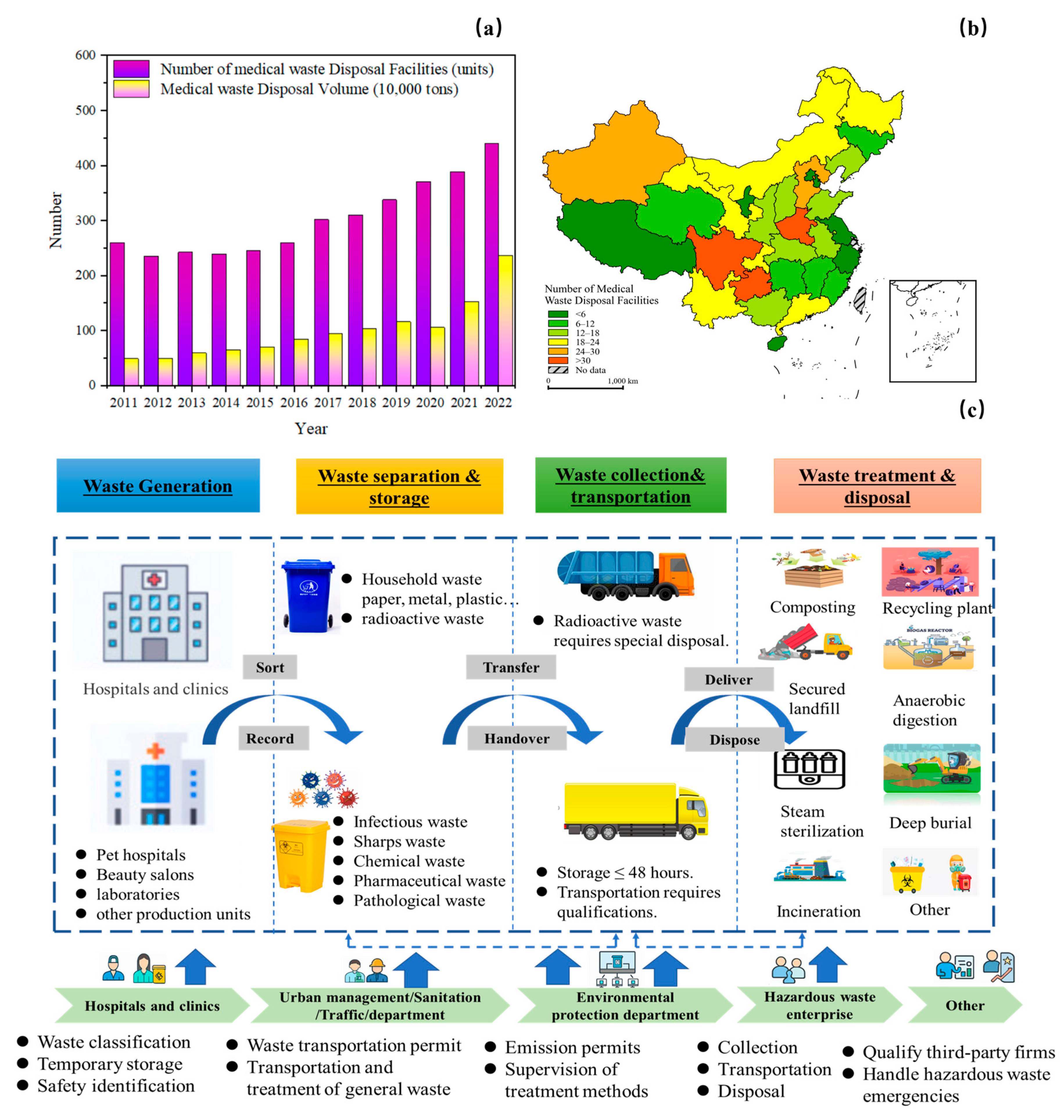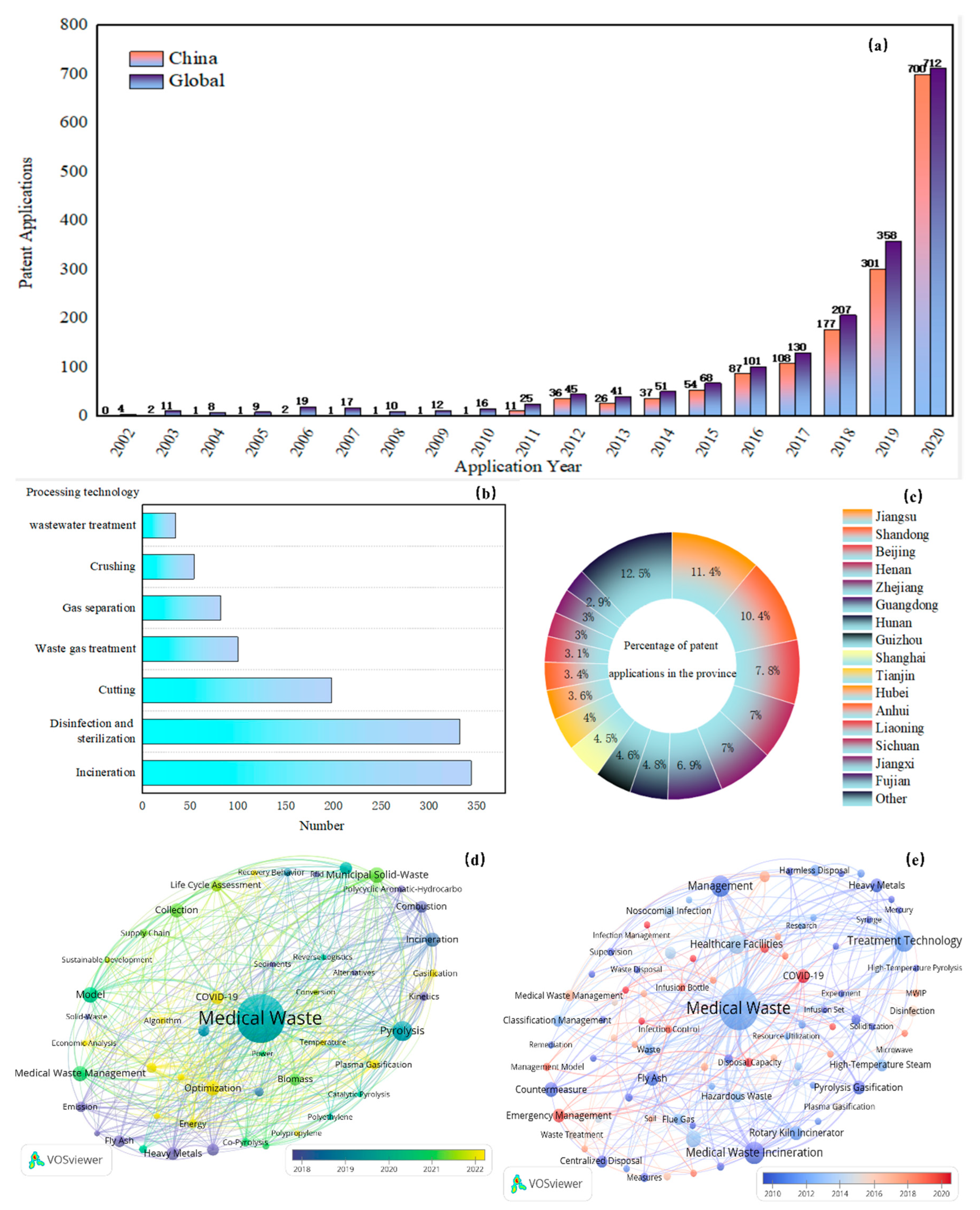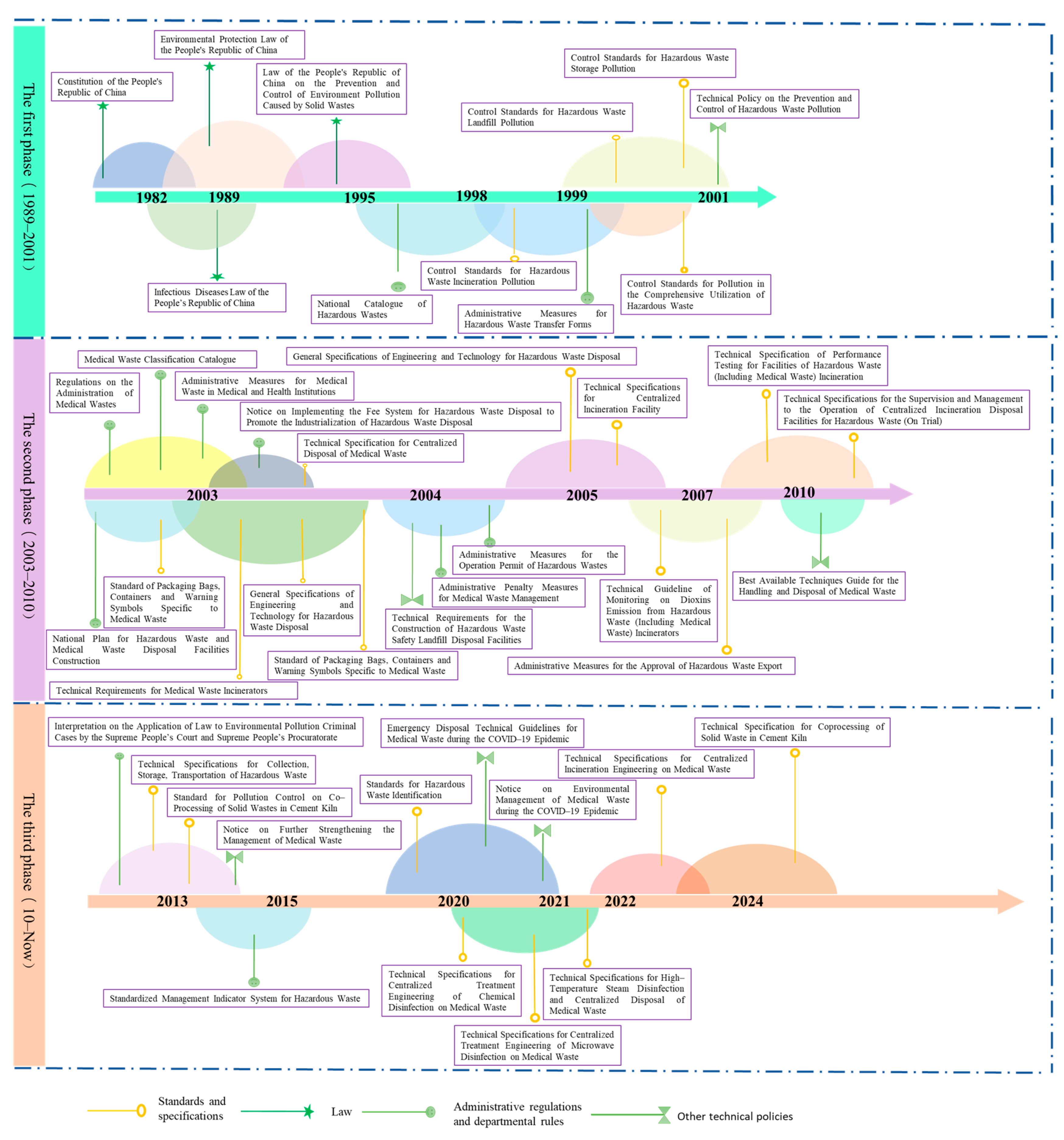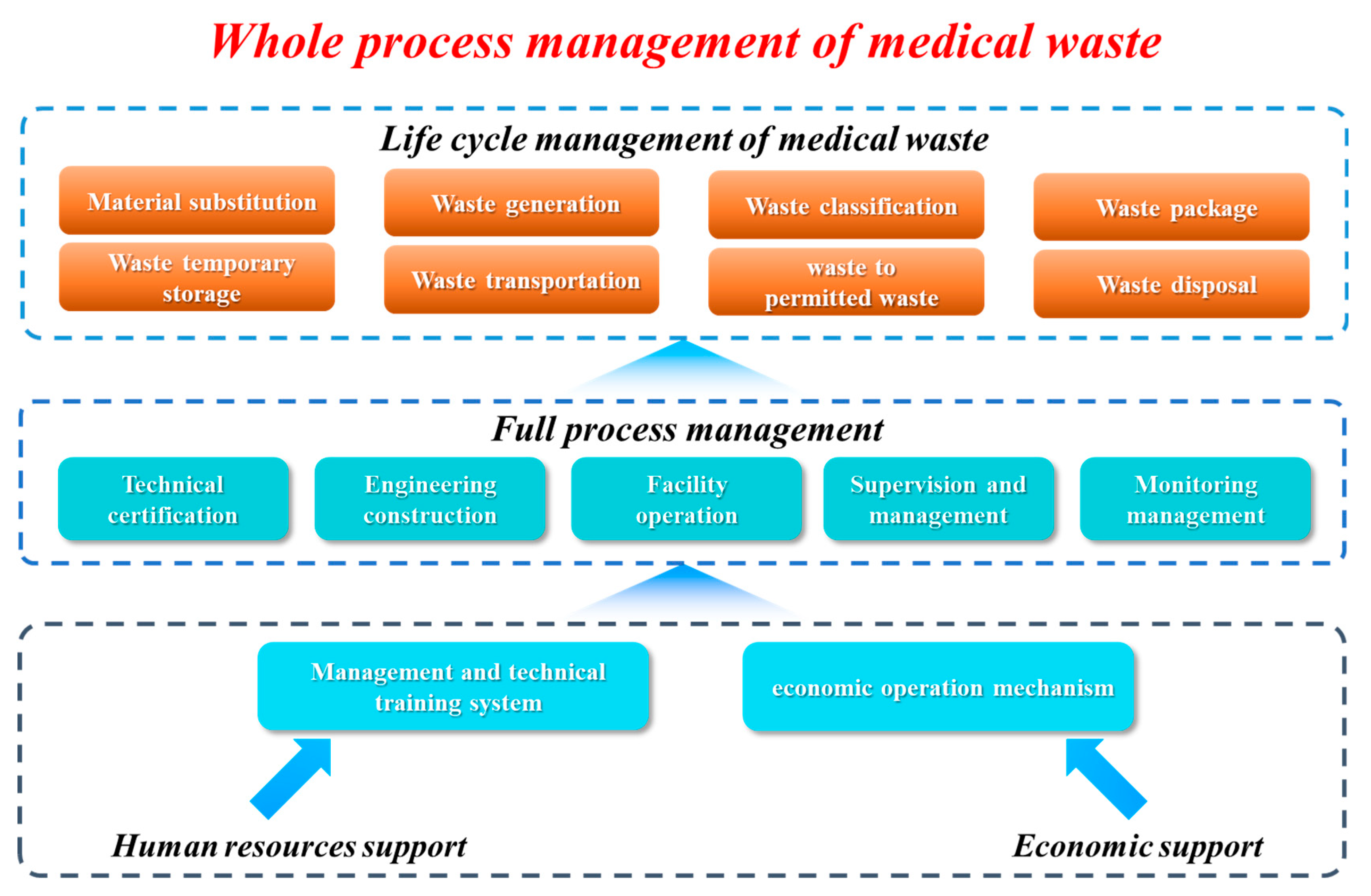Research on the Current Status and Future Development Prospects of Medical Waste Disposal Technologies and Management in China
Abstract
1. Introduction
2. Materials and Methods
2.1. Data Collection
2.2. Data Analysis and Visualization
3. Results and Discussion
3.1. Disposal Capacity of MW
3.2. Disposal Technologies for MW
3.3. The Evolution of Management Policies for MW
- (1)
- The management of MW lacks systematization throughout its entire lifecycle.
- (2)
- The policies for MW disposal technologies in remote areas are inadequate.
- (3)
- The emergency mechanisms for disposal technologies are inadequate.
3.4. The Sustainable Development Directions of MW
- (1)
- China should actively promote the establishment of a comprehensive lifecycle system aiming at achieving whole-process management from MW generation to disposal. This includes systematic management of the collection, classification, packaging, temporary storage, transportation, and treatment of MW to ensure compliance with environmental protection and safety standards at all stages. Additionally, as technology continues to develop, comprehensive technical certification should be implemented to ensure both applicability and effectiveness. Furthermore, engineering construction should prioritize the operational management of facilities to guarantee efficient equipment usage and oversight by environmental protection authorities. The implementation of monitoring management is essential and should be integrated with the facility operation and supervision to enable real-time tracking and assessment of management effectiveness. Figure 4 clearly illustrates the proposed blueprint for China’s management system for MW technology. The primary objective is to establish a comprehensive MW management infrastructure that addresses the urgent needs in environmental, economic, social, and institutional aspects, ultimately fostering the sustainable development of MW management.
- (2)
- The methods for constructing and developing MW disposal systems in China should prioritize the coordination between routine operations and emergency response efforts. Cities should effectively allocate existing disposal facilities and adopt diverse strategies to strengthen emergency preparedness. As shown in Table 2, cities with municipal solid waste incineration facilities can manage MW through two main approaches: ① Hospitals can be responsible for onsite disinfection of MW, which is then sent to municipal solid waste incineration facilities for disposal. ② Municipal solid waste incineration facilities can assist in the disposal of MW, typically maintaining an incineration rate of below 5%. In remote areas facing epidemics, it is recommended to implement in situ rapid start and stop disposal technologies. Nationwide, efforts should continue to enhance the infrastructure for both routine and emergency MW disposal facilities, accelerate the development of centralized MW disposal facilities, and enhance the treatment and disposal capacity for MW.
4. Conclusions
Supplementary Materials
Author Contributions
Funding
Institutional Review Board Statement
Informed Consent Statement
Data Availability Statement
Conflicts of Interest
References
- Goodarzian, F.; Ghasemi, P.; Gunasekaran, A.; Labib, A. A fuzzy sustainable model for COVID-19 medical waste supply chain network. Fuzzy Optim. Decis. Mak. 2024, 23, 93–127. [Google Scholar] [CrossRef]
- Lotfi, R.; Kargar, B.; Gharehbaghi, A.; Weber, G.-W. Viable medical waste chain network design by considering risk and robustness. Environ. Sci. Pollut. Res. 2022, 29, 79702–79717. [Google Scholar] [CrossRef] [PubMed]
- Maihami, R.; Ghalehkhondabi, I. Pricing problem in a medical waste supply chain under environmental investment: A game theory approach. J. Ind. Prod. Eng. 2022, 39, 597–613. [Google Scholar] [CrossRef]
- Hai, T.L.; Khoi, L.Q.; The, A.N.; Khoa, T.D.; Hong, K.V.; Huong, H.L.; Hieu, L.V.; Khiem, H.G.; Loc, V.C.P.; Duy, N.T.Q.; et al. Medical waste Chain: A medical waste collection, classification and treatment management by blockchain technology. Computers 2022, 11, 113. [Google Scholar] [CrossRef]
- Dihan, M.R.; Abu Nayeem, S.M.; Roy, H.; Islam, M.S.; Islam, A.; Alsukaibi, A.K.D.; Awual, M.R. Healthcare waste in Bangladesh: Current status, the impact of COVID-19 and sustainable management with life cycle and circular economy framework. Sci. Total Environ. 2023, 871, 162083. [Google Scholar] [CrossRef]
- China’s Ministry of Ecology and Environment. 2022 Annual Report on China’s Ecological Environment Statistics. 29 December 2023. Available online: https://www.mee.gov.cn/hjzl/sthjzk/sthjtjnb/202312/t20231229_1060181.shtml (accessed on 6 October 2024).
- Wang, J.; Shen, J.; Ye, D.; Yan, X.; Zhang, Y.; Yang, W.; Li, X.; Wang, J.; Zhang, L.; Pan, L. Disinfection technology of hospital wastes and wastewater: Suggestions for disinfection strategy during coronavirus disease 2019 (COVID-19) pandemic in China. Environ. Pollut. 2020, 262, 114665. [Google Scholar] [CrossRef] [PubMed]
- Rene, E.R.; Sethurajan, M.; Ponnusamy, V.K.; Kumar, G.; Dung, T.N.B.; Brindhadevi, K.; Pugazhendhi, A. Electronic waste generation, recycling and resource recovery: Technological perspectives and trends. J. Hazard. Mater. 2021, 416, 125664. [Google Scholar] [CrossRef]
- Zambrano-Monserrate, M.A.; Alejandra Ruano, M.; Sanchez-Alcalde, L. Indirect effects of COVID-19 on the environment. Sci. Total Environ. 2020, 728, 138813. [Google Scholar] [CrossRef]
- Zhang, D.; Ling, H.; Huang, X.; Li, W.; Chuan, Y.; Zhang, T.; Jiang, Y.; He, Y.; Deng, S.; Zhang, X.; et al. Potential spreading risks and disinfection challenges of medical wastewater by the presence of severe acute respiratory syndrome coronavirus 2 (SARS-CoV-2) viral RNA in septic tanks of Fangcang hospital. Sci. Total Environ. 2020, 741, 140445. [Google Scholar] [CrossRef]
- Qiao, M.; Ying, G.-G.; Singer, A.C.; Zhu, Y.-G. Review of antibiotic resistance in China and its environment. Environ. Int. 2018, 110, 160–172. [Google Scholar] [CrossRef]
- Liu, L.; Gong, Y.; Miao, Y.; Guo, J.; Long, H.; Feng, Q.; Chen, Y. New trends in pollution prevention and control technology for healthcare and medical waste disposal in China. Processes 2023, 12, 7. [Google Scholar] [CrossRef]
- Peng, Y.; Wu, P.; Schartup, A.T.; Zhang, Y. Latest insights on technologies for the treatment of solid medical waste: A review. J. Environ. Chem. Eng. 2023, 11, 109309. [Google Scholar] [CrossRef]
- Cao, Y.; Yu, X.; Yue, J.; Zhang, X.; Zhang, G.; Chen, G. Development and innovation of medical waste treatmentand disposal technology in China. China Environ. Prot. Ind. 2024, 46–53. [Google Scholar] [CrossRef]
- Cao, Y.; Yu, X.; Shan, S.; Wang, L.; Chen, G.; Zhang, Z.; Xu, J. Pollution prevention policy on medical waste treatment and disposal in China: Evolvement, problem analysis and suggestions. Chin. J. Environ. Eng. 2021, 15, 389–400. [Google Scholar]
- Zeng, Y.; Hesketh, T. The effects of China’s universal two-child policy. Lancet 2016, 388, 1930–1938. [Google Scholar] [CrossRef]
- Chinese News. China’s Urban Aging Big Data: 149 Cities are Deeply Aging, Concentrated in These Provinces. 6 September 2021. Available online: https://news.cctv.com/2021/09/06/ARTIYU6jcmpUupyuRlPDLXc8210906.shtml (accessed on 5 October 2024).
- Hantoko, D.; Li, X.; Pariatamby, A.; Yoshikawa, K.; Horttanainen, M.; Yan, M. Challenges and practices on waste management and disposal during COVID-19 pandemic. J. Environ. Manag. 2021, 286, 112140. [Google Scholar] [CrossRef]
- Ministry of Ecology and Environment. Annual Report on Environmental Prevention and Control of Solid Waste Pollution in Large and Medium Sized Cities. 18 December 2020. Available online: https://www.mee.gov.cn/hjzl/sthjzk/gtfwwrfz/ (accessed on 10 October 2024).
- Nabavi-Pelesaraei, A.; Mohammadkashi, N.; Naderloo, L.; Abbasi, M.; Chau, K. Principal of environmental life cycle assessment for medical waste during COVID-19 outbreak to support sustainable development goals. Sci. Total Environ. 2022, 827, 154416. [Google Scholar] [CrossRef]
- Prata, J.C.; Silva, A.L.P.; Walker, T.R.; Duarte, A.C.; Rocha-Santos, T. COVID-19 pandemic repercussions on the use and management of plastics. Environ. Sci. Technol. 2020, 54, 7760–7765. [Google Scholar] [CrossRef]
- Chen, Y.; Feng, Q.; Liu, L.; Chen, R.; Zhang, Y.; Bao, Z. Reform and development of medical waste disposal technology system in the new era. Chin. J. Environ. Eng. 2021, 15, 383–388. [Google Scholar]
- NPC Standing Committee. Law of the People’s Republic of China on the Prevention and Treatment of Infectious Diseases. 29 June 2013. Available online: http://www.npc.gov.cn/zgrdw/npc/zfjc/zfjcelys/2018-06/15/content_2056044.htm (accessed on 9 October 2024).
- Chinese Government Website. Environmental Protection Law of the People’s Republic of China. 13 November 2012. Available online: https://www.gov.cn/bumenfuwu/2012-11/13/content_2601277.htm (accessed on 9 October 2024).
- Ministry of Ecology and Environment of the People’s Republic of China. National Hazardous Waste List (2021 Edition). 25 November 2020. Available online: https://www.mee.gov.cn/gzk/gz/202112/t20211213_963867.shtml (accessed on 9 October 2024).
- Central People’s Government. Regulations on the Management of Medical Waste. 2 August 2005. Available online: https://www.gov.cn/banshi/2005-08/02/content_19238.htm (accessed on 9 October 2024).
- National Development and Reform Commission. National Plan for the Construction of Hazardous Waste and Medical Waste Disposal Facilities. 23 May 2004. Available online: https://www.ndrc.gov.cn/fggz/hjyzy/hjybh/200507/t20050711_1161186.html (accessed on 9 October 2024).
- Zhang, N.; Lu, D.; Sheng, H.; Xia, J.; Kan, P.; Yao, Z.; Chen, H.; Li, G.; Zhu, D.Z.; Liu, H. Constructed wetlands as hotspots of antibiotic resistance genes and pathogens: Evidence from metagenomic analysis in Chinese rural areas. J. Hazard. Mater. 2023, 447, 130778. [Google Scholar] [CrossRef]
- Kumar, M.; Patel, A.K.; Shah, A.V.; Raval, J.; Rajpara, N.; Joshi, M.; Joshi, C.G. First proof of the capability of wastewater surveillance for COVID-19 in India through detection of genetic material of SARS-CoV-2. Sci. Total Environ. 2020, 746, 141326. [Google Scholar] [CrossRef] [PubMed]
- Hu, Y.; Cheng, H.; Tao, S. Environmental and human health challenges of industrial livestock and poultry farming in China and their mitigation. Environ. Int. 2017, 107, 111–130. [Google Scholar] [CrossRef] [PubMed]
- Bungau, S.; Bungau, C.; Tit, D.M. Studies on the last stage of product lifecycle management for a pharmaceutical product. J. Environ. Prot. Ecol. 2015, 16, 56–62. [Google Scholar]
- Tit, D.M.; Bungau, S.; Cseppento, N.; Copolovici, D.M.; Buhas, C. Disposal of unused medicines resulting from home treatment in Romania. J. Environ. Prot. Ecol. 2016, 17, 1425–1433. [Google Scholar]




| Type | Incineration | Non-Incineration | ||||
|---|---|---|---|---|---|---|
| Rotary Kiln Firing | Pyrolysis Incineration | High-Temperature Steam-Based | Chemical | Microwave | High-Temperature Dry Heat | |
| Scope can be treated | Acceptable for all waste types | Infectious and damaging MW | ||||
| Processing scale | >10 t·d−1 | 5–10 t·d−1 | One unit < 10 t·d−1 | |||
| Equipment requirements | High temperature and corrosion resistance | High temperature and corrosion resistance | High-temperature and high-pressure resistant, sealed, and insulated | Corrosion-resistant, negative-pressure operation | Electromagnetic protection, sealed, and high-temperature resistant | Corrosion-resistant, negative-pressure operation |
| Assignment method | Continuous operation | Continuous/Intermittent Operation | Intermittent Operation | |||
| Pollutants emission | PCDD/PCDFs, SO2, HCl, NOx, heavy metals, etc. | Odor, VOCs | VOCs, waste gas disinfectant | VOCs, microwave radiation | Odor, VOCs | |
| Disadvantages | High operating costs and specialized control of dioxins | Difficulty in achieving stable combustion, specialized control of dioxins | Condensate and steam boiler exhaust gas need to be treated | Easy to produce disinfectants Secondary pollution | Electromagnetic radiation Protection required | High requirements for temperature control |
| Advantages | Good disposal effect, strong adaptability, and large processing capacity | Low smoke and high heat utilization rate | Low operating costs, strong adaptability, minimal secondary pollution, no generation of pollutants such as dioxins, easy operation and management, and stable operating effects | |||
| Technical Approach | Application Scenarios | Disposal Measures |
|---|---|---|
| Hospital on-site disinfection treatment + disposal at a waste-to-energy plant | Cities within the region with existing municipal waste incineration facilities | Leveraging hospitals for on-site disinfection of MW, with the disinfected waste then transferred to municipal waste incineration facilities for disposal by incineration. |
| Coordinated disposal of municipal solid waste incineration facilities | Cities within the region that have existing municipal waste incineration facilities | Relying on domestic waste incineration facilities to form an MW co-disposal capacity. By setting up a special feeding port for MW and related supporting facilities, the domestic waste incineration facilities are utilized for the co-disposal of MW in routine and emergency situations, and the proportion of MW blended in is generally no more than 5%. |
| Centralized MW treatment facility | All cities | Utilizing the facilities of the Centralized Medical Expense Disposal Center (CMEDC) for the treatment and disposal of MW. Applicable to traditional and emergency disposal of MW. |
| Miniaturized in situ rapid start and stop safe disposal technology | Outbreaks and remote areas | Emergency treatment of MW in cities (or counties) during traditional and epidemic situations; emergency treatment of MW in earthquake and other disaster areas; routine and emergency treatment of MW in remote areas. |
Disclaimer/Publisher’s Note: The statements, opinions and data contained in all publications are solely those of the individual author(s) and contributor(s) and not of MDPI and/or the editor(s). MDPI and/or the editor(s) disclaim responsibility for any injury to people or property resulting from any ideas, methods, instructions or products referred to in the content. |
© 2025 by the authors. Licensee MDPI, Basel, Switzerland. This article is an open access article distributed under the terms and conditions of the Creative Commons Attribution (CC BY) license (https://creativecommons.org/licenses/by/4.0/).
Share and Cite
Cun, M.; Wang, K.; Yang, S.; Guo, J.; Liu, G.; Yin, Z.; Wang, T.; Sun, M.; Feng, Q.; Liu, L.; et al. Research on the Current Status and Future Development Prospects of Medical Waste Disposal Technologies and Management in China. Sustainability 2025, 17, 5571. https://doi.org/10.3390/su17125571
Cun M, Wang K, Yang S, Guo J, Liu G, Yin Z, Wang T, Sun M, Feng Q, Liu L, et al. Research on the Current Status and Future Development Prospects of Medical Waste Disposal Technologies and Management in China. Sustainability. 2025; 17(12):5571. https://doi.org/10.3390/su17125571
Chicago/Turabian StyleCun, Meng, Kaiyue Wang, Shitong Yang, Jianbo Guo, Guiying Liu, Zhibin Yin, Tongzhe Wang, Mingnan Sun, Qinzhong Feng, Liyuan Liu, and et al. 2025. "Research on the Current Status and Future Development Prospects of Medical Waste Disposal Technologies and Management in China" Sustainability 17, no. 12: 5571. https://doi.org/10.3390/su17125571
APA StyleCun, M., Wang, K., Yang, S., Guo, J., Liu, G., Yin, Z., Wang, T., Sun, M., Feng, Q., Liu, L., & Chen, Y. (2025). Research on the Current Status and Future Development Prospects of Medical Waste Disposal Technologies and Management in China. Sustainability, 17(12), 5571. https://doi.org/10.3390/su17125571










